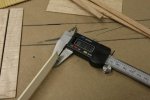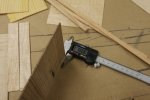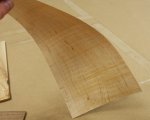When I had a Performax (Jet) drum sander with cloth belt directly on the drum, and thin sandpaper as the feed belt, each pass was precise, and an extra pass took almost nothing off. I dared run the drum close to the feed belt.
Now that I have upgraded(?) to a Woodmaster 5 hp 38" sander, the belt is attached to the drum with spongy Velcro, and the feed belt is a thick rubber mesh, so I can get significant wood removal for three passes without adjusting the depth/height of the sander. With this kind of machine, you don't want to risk the very expensive feed belt, so the minimum thickness isn't very minimum - hence the backer board is to keep the expensive sandpaper away from the expensive feed belt, in case something goes wrong. (There are advantages to the Velcro sandpaper and the rubber feed belt, but very thin, precise thickness sanding is not one of them).










